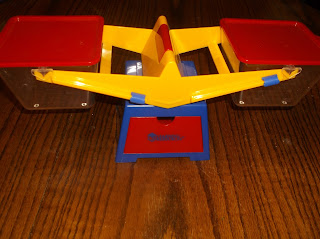A couple years ago after reading The 7 Habits of Highly Effective People, Cameron and I began a discussion that lasted throughout the whole year. It started with a question--in 30 years what values do we want our children to embrace, and what do we want their lives to look like? By the end of the year we had drummed out a list of values we want to deliberately teach our children--things like love, faith, gratitude, and integrity. Then, because there were 12 of them, we decided that each month we would celebrate a different value. We try to give each month's value lots of emphasis with family discussions and activities.
In May our value is health. We want our children to understand that when they eat healthily and exercise they show respect for the body God gave them. They will also feel better and live better. This year we stumbled upon a wonderful visual to help bring the point home for the kids.
I got this idea from the book The Human Body: 25 Fantastic Projects Illuminate How the Body Works, but I simplified it a little for my kids' ages. All you really need is a balance and some dry beans (we used pinto beans.)
We used this Learning Resources balance, which we have as part of our homeschool math toys. If you don't have a balance and don't want to buy one, there are instructions for making one in the book.
I started by looking up basic nutritional needs for my kids using the standards on choosemyplate.gov. Then I colored a bean for each serving of each food group that my kids need each day. For us that was five beans for grains (I colored them orange with a marker), four red-colored beans for protein (I combined dairy into the protein category to make things simpler), and five beans colored green to represent fruits and vegetables.
Once you have your beans colored you can set them aside.
Choose an equal number of plain, uncolored beans to put in one side of your balance.
Then throughout the day after meals and snacks talk to your child about what they have eaten, how many servings that covers, and which food groups are represented. Move the appropriate beans into the empty end of the balance. At the end of the day if they've eaten all the right things their diet will balance.
We rotated so each of my kids would have a turn on different days to use the balance. They got excited about it and loved seeing their diet balance. I loved the increased awareness of what food groups our bodies need, serving sizes, and how many of each we need every day. Teaching children about good nutrition and how to care for their bodies is a wonderful life skill to begin when they are young.




No comments:
Post a Comment